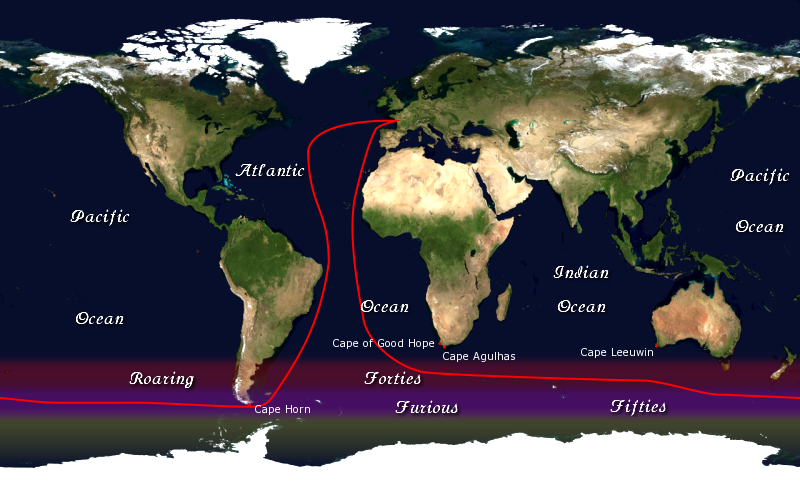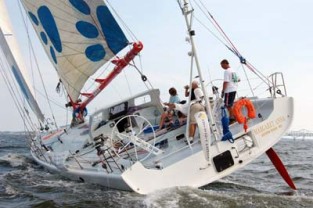On November 6th, twenty nine sailors will launch from Les Sables d'Ollone, France, for the start of the 7th Vendee Globe. Run every four years since 1989, the Vendee is the only single-handed (solo) nonstop around the world race and as such is arguably the most challenging event in the sporting world.
As shown in the graphic, the Vendee starts in France and runs south along the coast of Africa to the Cape of Good Hope. From there the racers take a course roughly due east, between the 40th and 50th parallel, south of Australia to Cape Horn - in essence circling Antarctica. After rounding Cape Horn they turn left for the run back to France.
The route takes the racers through some of the most difficult and dangerous waters on the planet - the renowned "Roaring Forties" and "Furious Fifties". A stretch of the Southern Ocean totally uninterrupted by land, where the prevailing easterly winds continuously circle the globe. In the worst conditions typically encountered, wind speeds can reach 80 knots sustained and wave heights can, in the vicinity of Cape Horn, reach 100'. The sailors must manage these conditions aboard a 60' boat, alone - no external assistance is allowed and is grounds for automatic disqualification.
Most of the racers in the International Monohull Class Association (IMOCA) are from France, where ocean racing is the national sport. This year the United States is represented by Rich Wilson, for the second time (Wilson also competed in the 2008/09 edition). Rich, who hails from the Boston area, is 66 years old - one of 3 sailors in this year's race over the age of 60.
For those who have experienced the thrill of ocean racing, the Vendee is the Super Bowl, the World Cup and summiting Everest, all rolled up into one event. For those who know little or nothing about the sport, the Vendee is a curiosity on the level of, perhaps, a NASCAR race at Talladega - something really exciting and potentially tragic is bound to happen. There are boat casualties in every race and there have been, on several occasions, human casualties as well.
Since the average run time of the race is something on the order of 85 days (the record is 78 and change and the slowest completions take around 100) the early November start means that the event will finish sometime in late January. I'll provide weekly updates, links to videos and race reports. If someone needs to be rescued by the Australian Navy, I'll track that, as well.
I'm not expecting everyone to be interested in this event, but for even the most casual fan of sporting events in general, it is interesting. For those with any interest, stay tuned and feel free to discuss. For those not interested there's the rest of football season and maybe a "hot chicks" thread.

As shown in the graphic, the Vendee starts in France and runs south along the coast of Africa to the Cape of Good Hope. From there the racers take a course roughly due east, between the 40th and 50th parallel, south of Australia to Cape Horn - in essence circling Antarctica. After rounding Cape Horn they turn left for the run back to France.
The route takes the racers through some of the most difficult and dangerous waters on the planet - the renowned "Roaring Forties" and "Furious Fifties". A stretch of the Southern Ocean totally uninterrupted by land, where the prevailing easterly winds continuously circle the globe. In the worst conditions typically encountered, wind speeds can reach 80 knots sustained and wave heights can, in the vicinity of Cape Horn, reach 100'. The sailors must manage these conditions aboard a 60' boat, alone - no external assistance is allowed and is grounds for automatic disqualification.
Most of the racers in the International Monohull Class Association (IMOCA) are from France, where ocean racing is the national sport. This year the United States is represented by Rich Wilson, for the second time (Wilson also competed in the 2008/09 edition). Rich, who hails from the Boston area, is 66 years old - one of 3 sailors in this year's race over the age of 60.
For those who have experienced the thrill of ocean racing, the Vendee is the Super Bowl, the World Cup and summiting Everest, all rolled up into one event. For those who know little or nothing about the sport, the Vendee is a curiosity on the level of, perhaps, a NASCAR race at Talladega - something really exciting and potentially tragic is bound to happen. There are boat casualties in every race and there have been, on several occasions, human casualties as well.
Since the average run time of the race is something on the order of 85 days (the record is 78 and change and the slowest completions take around 100) the early November start means that the event will finish sometime in late January. I'll provide weekly updates, links to videos and race reports. If someone needs to be rescued by the Australian Navy, I'll track that, as well.
I'm not expecting everyone to be interested in this event, but for even the most casual fan of sporting events in general, it is interesting. For those with any interest, stay tuned and feel free to discuss. For those not interested there's the rest of football season and maybe a "hot chicks" thread.




